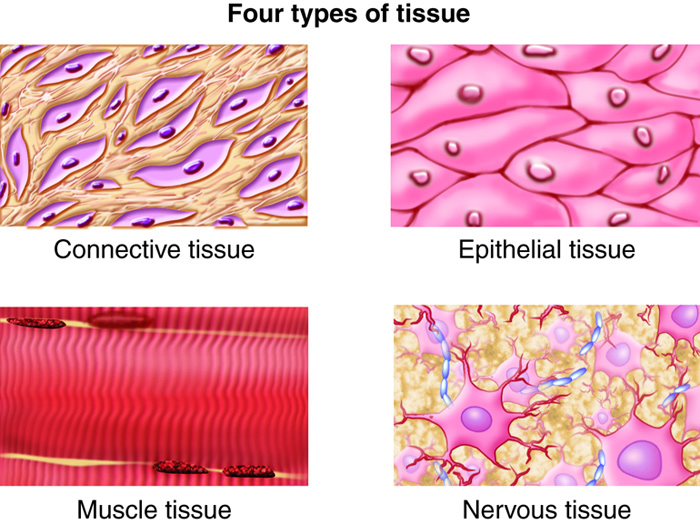16 Tissues
In the body’s organizational hierarchy, tissues occupy a place between cells and organs. That is, a tissue is a group of cells with a similar shape and function. In turn, organs (which make up the body) are comprised of various tissues.
The component cells of a tissue are a specific cell type. A tissue’s cells may be identical, but are not necessarily so. Several tissues will comprise an organ. For example, the contractile cells of skeletal muscle are bundled together to make muscle fiber tissue. In turn, endomysium cells form enclosing tissue that wraps around bundles of muscle fibers, like a tortilla around the filling of a burrito. Several of these structures are in turn wrapped by another tissue, perimysium. Finally, bundles of these are surrounded by a sheath of yet another tissue, epimysium, which covers the outside of the whole muscle. Yet more tissue is necessary for the muscle to function in the body. Connective tissue comprising ligaments attaches the muscle to the skeleton, and nerve tissue conducts impulses from the nervous system to signal the muscle to contract.
Skeletal muscle is only one kind of tissue. The body is made of dozens of different tissues, but broadly speaking there are four types of tissues.
- Muscle tissue (in turn divided into skeletal, smooth and cardiac) is contractile. It allows locomotion of the body. It also allows necessary contractions of various organs such as the heart and of respiratory and digestive systems.
- Nerve tissue comprises the body’s wiring system. It conducts signals between the nervous system and various organs.
- Connective tissue holds the body together. It is found in most organs, anchoring them to the skeleton and other organs. Types of connective tissue include fibrous tissue, fatty tissue, loose tissue and cartilage. Connective tissue also includes bone, blood and lymph.
- Epithelial tissue is the body’s protection against the outside environment. Skin tissue helps to maintain homeostasis. It helps monitor and control temperature, and resists abrasion, foreign bodies and damaging chemicals. Internally, epithelial tissue lines most internal cavities, secreting or absorbing nutrients.

Tissues form during development. Stem cells in the embryo differentiate into various cell types. The necessary genes in the cells turn on or off, resulting in the production of proteins that characterize a cell’s structure and function. Early in embryonic growth, the cells migrate to the appropriate location in the body. Once there, they proliferate so that the tissue can perform its needed function.
Different tissues arise from the source cells in each of the three primary germ cell layers. For example, the epithelium is derived from the ectoderm and endoderm. Connective tissue arises largely from the mesoderm. Gastrointestinal and respiratory tissues arise mostly from the endoderm. Programmed cell death, or apoptosis, may take place to eliminate transitory tissues in the embryo, such as the pronephros, a simple excretory organ that is later replaced by the kidney.

